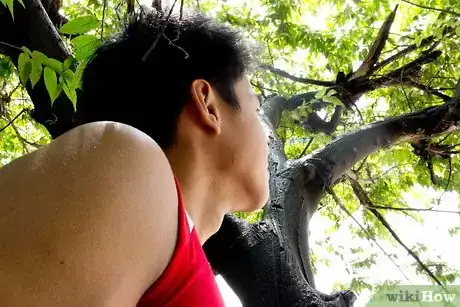wikiHow is a “wiki,” similar to Wikipedia, which means that many of our articles are co-written by multiple authors. To create this article, 24 people, some anonymous, worked to edit and improve it over time.
This article has been viewed 86,247 times.
Learn more...
Trees are a source of wonder and beauty for many people who gaze upon them and spend time around them. People from all walks of life come into contact with trees daily - hikers, gardeners, artists, lovers of the great outdoors, dreamers, naturalists, travelers and tourists, hunters, botanists, and more. By dint of being rooted to the ground they grow in, trees are representative of strength and constancy for many and this can bring on a sense of peace and connection when spending time around trees.
Listening to trees is either a relaxation or a meditating exercise, depending on how you choose to view it. Listening to the communications of trees (or rustlings and noises if you're really practical) is a way of attuning our hearing and paying more attention to what we hear around us rather than letting sounds invade our space unawares. Trees make for a wonderful subject of focus because they cannot move more than what the breeze blows, toning down distractions and causing us to relax and focus more clearly.
Steps
-
1Find a suitable place for spending time with the trees. Choose a place that has at least two trees but preferably more. It is better that they have abundant foliage but even branches, twig, and bark have a place in making sounds. Make yourself comfortable and settled; you may wish to face the trunk(s) or sit against a trunk, or sit in the middle of a circle of trees. Do whatever feels right around the trees, as there are no rules, just instinctual responses.
- It is best if you can allow yourself to be led to the trees where you will listen. Actively avoiding choosing a particular tree to meditate or relax before you arrive can lead you to a tree with which you are unfamiliar and you may learn much more by interacting with it.
-
2Be prepared to spend a decent amount of time on this exercise. Trees are very noble and peaceful. They neither welcome the bird nor beckon for its return. They let things be as they are. Therefore, they won't welcome your willingness to listen, they'll only see you as you are and continue with their normal behavior. However, be sure to treat the trees with respect and this respect will emanate from you and become part of the microcosm of you and the trees, not acknowledged but always gently there. Your respect for the trees will improve your ability to listen, as well as helping you to be open to the possibilities that you may never have pondered before.Advertisement
-
3Notice the silence. In looking for the silence, you will soon become aware that a copse of trees, a wood, or a forest has no real silence. The trees are always communicating, making noise, filling in the gaps between bird song and the industrious animals and insects.
-
4Notice the sounds with greater precision. You will hear the trees in the breeze or wind, the swaying of branches, the creaking of limbs, the rustling of leaves. Listen to how the wind or breeze flows through the trees and the how the very smallest of the sounds of the trees are amplified by the fact of you choosing to listen more closely.
- Be patient. It takes time and perseverance to learn to listen to the trees. Don't be disappointed if you cannot hear the trees at first. It may take several different tries and occasions before you tap into the interactions.
-
5Experiment with sounds around and beneath the tree. The sounds are quiet, so listen closely and attentively.
- Place your ear to the ground, perhaps above the roots of the tree. Can you hear anything approaching?
- Place your ear against the trunk of the tree. Listen for what you can hear; once you hear it, let the sound envelop you and create a reaction in you. How does hearing sounds through the trunk affect you?
-
6Repeat the exercise of listening over and over. As you listen, continue asking yourself how you are affected by the sounds of the tree. What is the quality of the sound and where does it resonate most within your body? What does the sound actually do – is it constant, intermittent, loud, soft, or always changing? The more you persist with this line of inquiry and a focus on simply listening to the trees, the more you will attune your hearing to the communications from the trees.
-
7Listen with your other senses. It is possible for the deaf to "hear" when listening to trees.[1] Opening up your senses means noting which parts of your body are most in tune with the tree's methods of communicating, through touch, smell, sound and sight. Continue listening as your accepted ideas about communication and about trees are turned upside down.
- Inhale deeply and slowly exhale to feel the discourse of the trees within you.
-
8Repeat all meditative or relaxing steps as long as you like. Hopefully this will further enlighten you. If you have enjoyed this experience of spending time with trees, consider broadening your listening to the communication of the trees to also embrace listening to your own body. From the experience of trees, you can learn to nourish your body as the tree knows instinctively how to nourish itself – selectively, slowly in small amounts, and aligned with the environment and seasons around you. As with the tree, take only what you need when needed and hear your body's needs, energizing it through eating for your body rather than to jump start or sedate it, and learn from the trees how to get your life back into balance.[2]
Community Q&A
-
QuestionHow exactly will I know what they are saying?
 Community AnswerYou must try to feel you connection with the tree you are listening to, feel the vibrations and imagine what it is saying.
Community AnswerYou must try to feel you connection with the tree you are listening to, feel the vibrations and imagine what it is saying. -
QuestionHow do trees help me speak to others?
 Community AnswerFor there to be effective communication, there must first be careful listening. Learn from trees how to listen, and next time you want to communicate with someone, you will be better able to read their mood, notice their reactions to you, and so to choose words and tone that will connect well.
Community AnswerFor there to be effective communication, there must first be careful listening. Learn from trees how to listen, and next time you want to communicate with someone, you will be better able to read their mood, notice their reactions to you, and so to choose words and tone that will connect well. -
QuestionCan trees send bad vibes and keep people or animals away?
 Community AnswerThey could, but most likely will not. Trees are passive beings.
Community AnswerThey could, but most likely will not. Trees are passive beings.
Warnings
- If you cannot see the point of listening to the trees communicate, then this exercise isn't for you. You need to have an open mind, a willingness to explore, and a liking for meditative relaxation. By the same token, don't denigrate that which you choose not to understand; one day perhaps you will find it as enlightening as others do but for now, simply respect that it is not for you and leave it alone without passing judgment.⧼thumbs_response⧽
- Keep in mind that this is for meditation purposes only; the ideas expressed are metaphorical and should not be taken literally. Trees do not have brains and cannot "speak" in the formal sense of the word. However, anthropomorphizing them can be an excellent (if unorthodox) source of relaxation for some people. If the trees start telling you to do things, however, it may be time for a new hobby!⧼thumbs_response⧽
Things You'll Need
- A mat or other ground cover for sitting/lying upon (optional)
- Journal if you feel inspired to write while spending time listening to the trees
References
- ↑ Patrice Bouchardon, The Healing Energies of Trees, p. 68, (1999), ISBN 1-885203-71-3
- ↑ Dara Boland, How to eat like a tree, pp. 20-22, (2000), ISBN 0-89087-945-1
- ↑ Diane K Osborn, A Joseph Campbell Companion, p. 11, (1991), ISBN 0-06-016718-1
- Patrice Bouchardon, The Healing Energies of Trees, (1999), ISBN 1-885203-71-3 – research source

































































